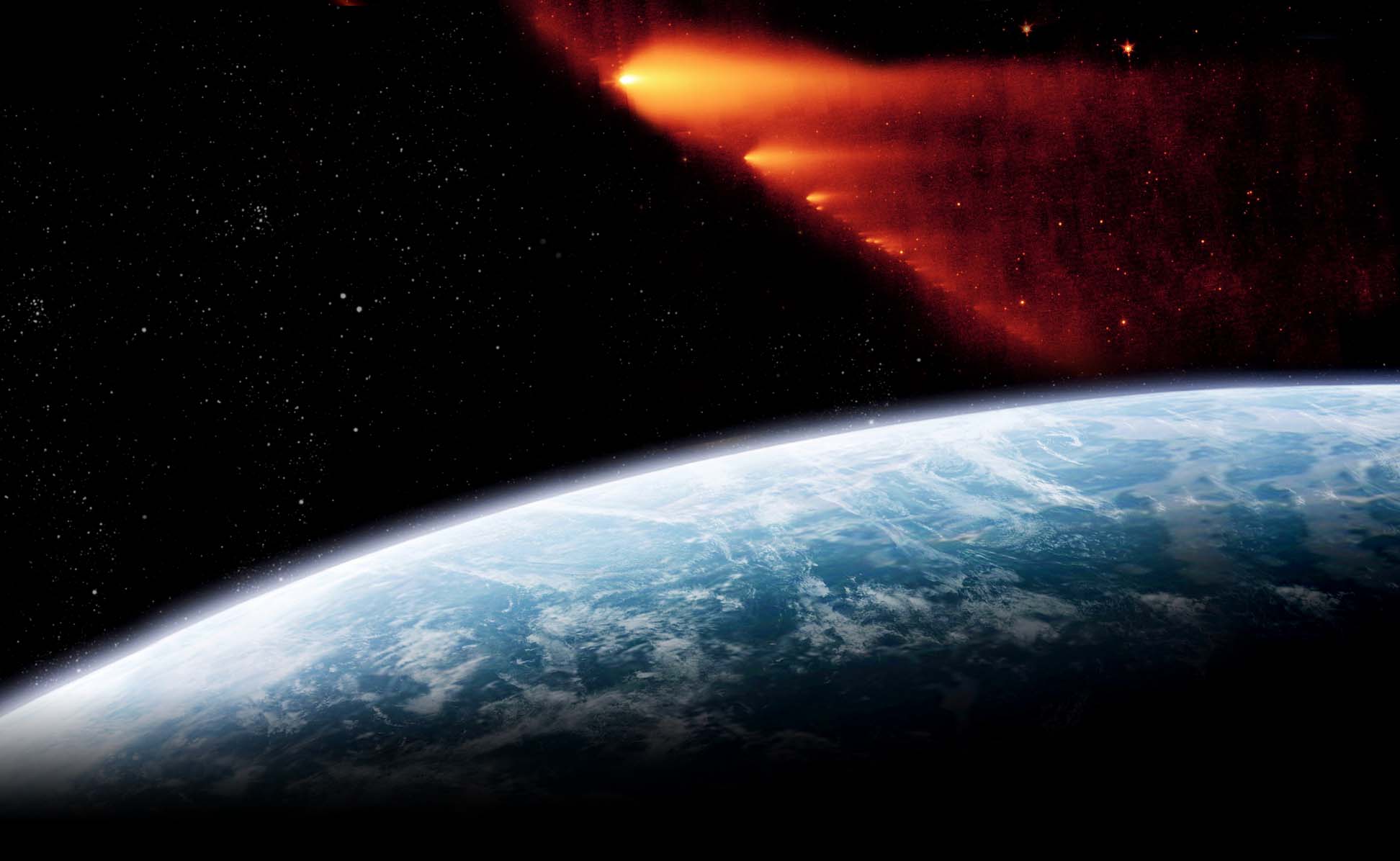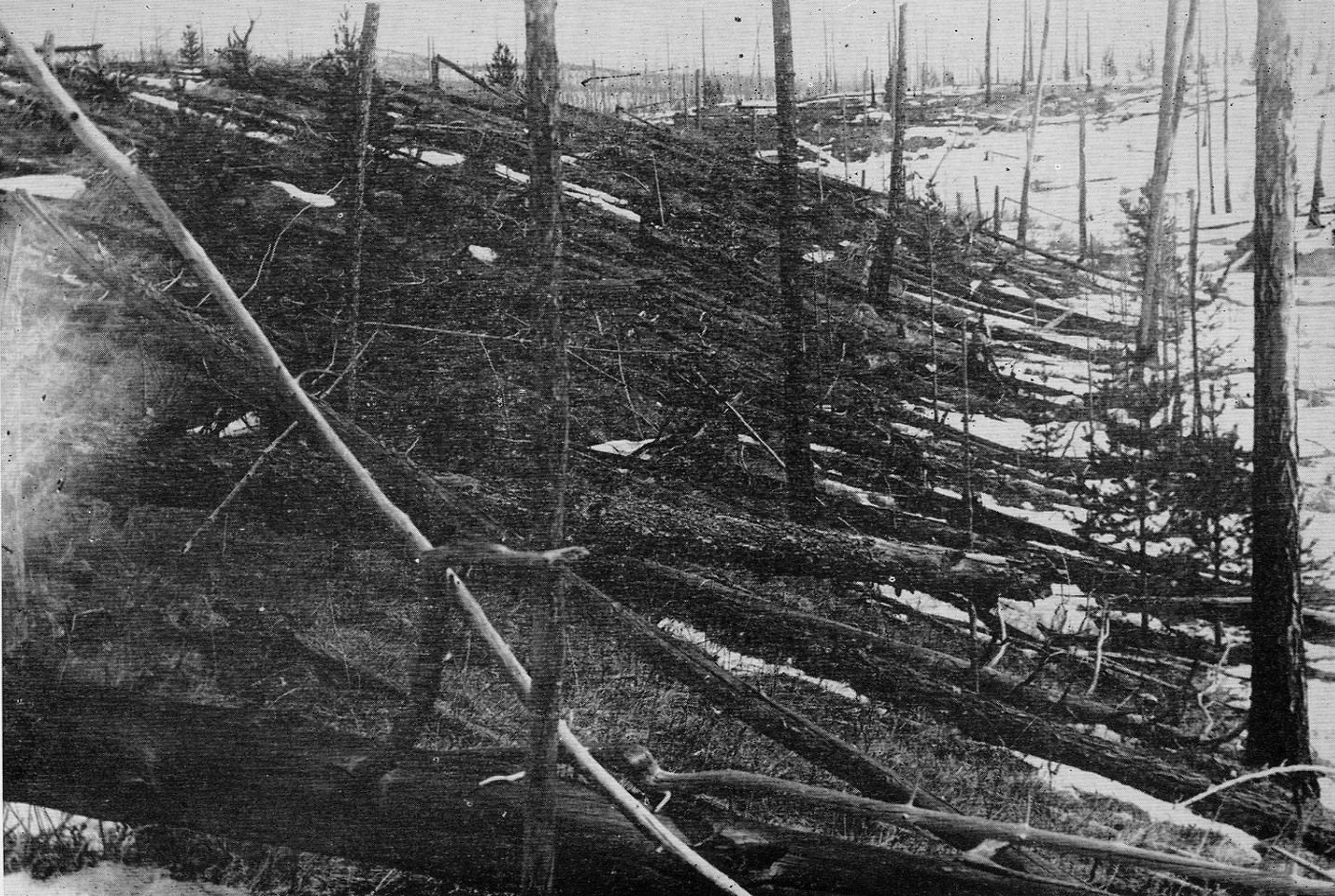
5 miles from ‘Ground Zero’ 20 years after the blast
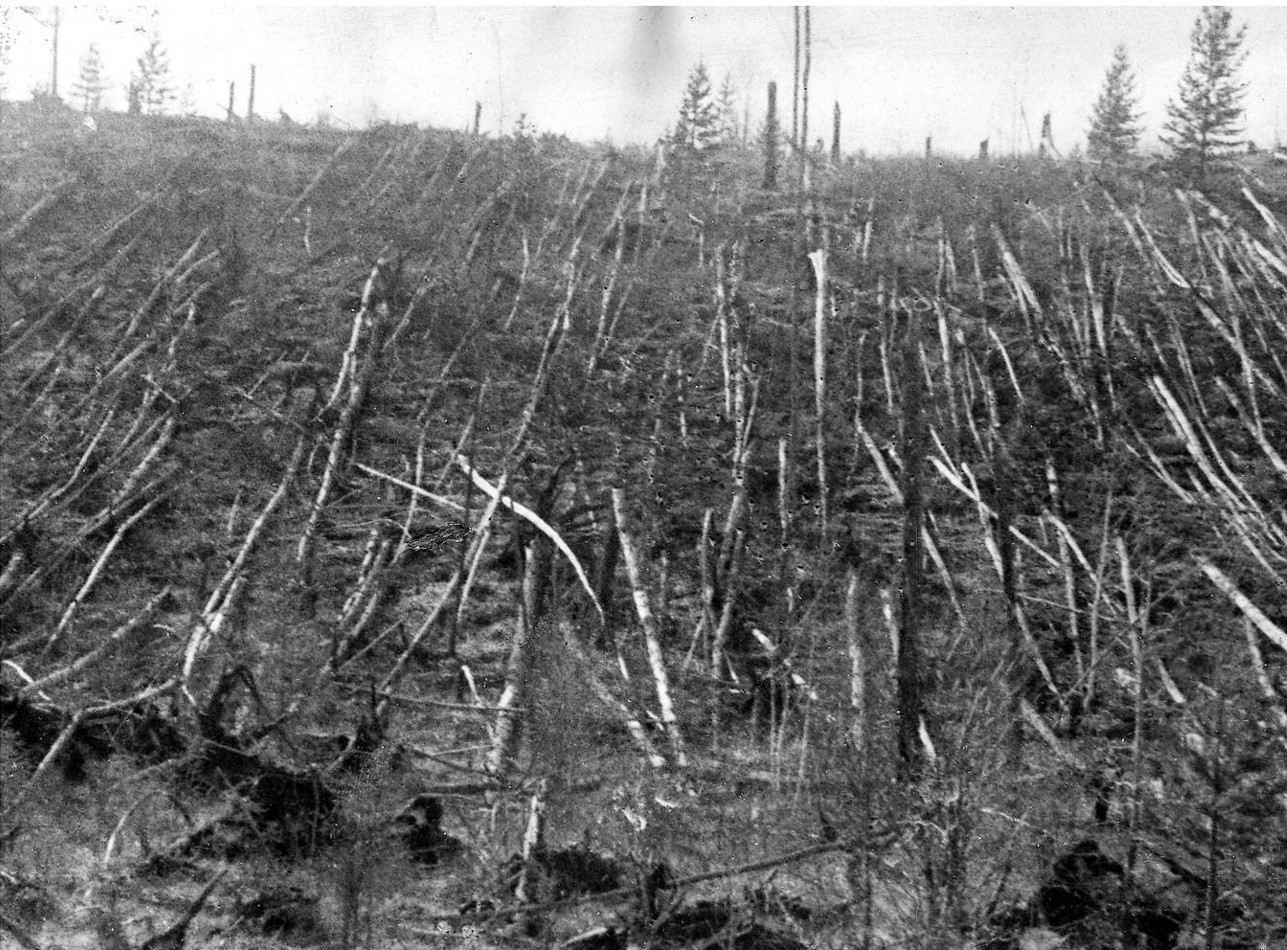
More forest devastation
Part 4 (Read Parts 1-3 “The Cosmic Factor”)
The Great Siberian Thunderbolt – 1
I have been discussing the language of cosmic symbolism that issued from the experiences of ancient people around the globe, and the intensified emphasis upon the sky that provides the key to understanding the forces of change at work during the transition from the Neolithic through the Bronze Age and into the Age of Iron, and earlier the transition from the Late Paleolithic to the Early Neolithic. To shed light on these dramatic environmental and social transformations I am going to turn to the most important and remarkable cosmic event of the Twentieth Century, the great Tunguska Event of June, 1908 and in doing so may come to a better understanding of why the sky and its wrathful deities became such an obsession for prehistoric peoples.
As of this writing, evidence continues to mount that the extraterrestrial realm has played a far more prominent role in both Earth history and human history than heretofore realized. In fact as I write these lines asteroid 1999 FN53, 3000 feet in diameter, is passing through near Earth space, and in spite of the hype and nonsense on the Internet it poses absolutely no danger to Earth, being some 6.3 million miles away. It does, however, remind us that we are not alone in the cosmic neighborhood. We now know that countless asteroids and comets have struck the Earth throughout its lifespan. Every year sees more evidence that these celestial encounters have happened far more frequently than anyone imagined a few generations ago.
Hopefully, we have not already forgotten what happened over the town of Chelyabinsk, Siberia, on February 15 of 2013. On that day a small asteroid, about 65 feet in diameter, entered Earth’s atmosphere at a high rate of speed and exploded with the force of a 500 kiloton blast, about 25 times more powerful than the atomic bomb blast that destroyed Hiroshima. Since the angle of approach was relatively shallow it exploded about 18 miles up in the atmosphere. Even at that height the powerful shockwave damaged over 7000 buildings in the region and caused over 1500 injuries, but, luckily, no fatalities. Had the object been somewhat larger, or arrived at a steeper angle, penetrating lower into the atmosphere, there could have been hundreds, or even thousands of people killed. Had that occurred it is likely that the impact of the Chelyabinsk meteor on the consciousness, and the priorities, of humankind would likely be somewhat different right now. As it is, awareness of the significance of that cosmic wake-up call is quickly fading from popular consciousness.
If the object that Earth encountered that day had a diameter about 2 ½ times larger, it would have been in the estimated size range of the object that exploded over Tunguska, eastern Siberia, in late June of 1908. By now many people have heard of this momentous event, but very few are familiar with the remarkable details. Actually, over the last several years I have been surprised at the number of people I have encountered, educated people at that, who had never even heard of the Tunguska Event. Looking back on the Twentieth Century from the long perspective of history, I would dare to say that the Tunguska event could very well turn out to be one of the most, if not the most important event of the modern age, right up there with World Wars, the invention of the Atomic Bomb and the Moon landing. Over the next several installments of this series I will delve into some of the details of what happened that day and the astonishing story they have to tell.
The date was June 30, a date that provides us with an important clue as to identity of the celestial intruder responsible for an explosion at least 1000 times more powerful than the Hiroshima atomic blast. Rather than 18 miles up in the atmosphere, as was the Chelyabinsk meteor when it exploded, this object detonated a mere 5 miles above the Earth’s surface. So powerful was the shock wave that over 800 square miles of old growth taiga forest were utterly decimated when the wave front hit the ground. An estimated 80 million huge trees were splayed out in a radial pattern from below the blast epicenter as if they were no more substantial than new mown hay. Almost one hundred square miles of forest directly below the epicenter was completely incinerated when it was engulfed in a fireball with a temperature some 40 thousand degrees Fahrenheit, almost 4 times hotter than the surface of the Sun.
We have no photographs of the event, no video footage or media coverage and no YouTube clips as we do with Chelyabinsk. In fact, the Tunguska event was not even known to the outside world until two decades after the fact. What we do have is the blast site itself and the clues it has yielded up to determined scientists and investigators, along with the accounts of a few hundred eyewitnesses that have been interviewed over the years, and some limited, but valuable instrumental data. These three sources of information together, however, have enabled the reconstruction of many details of this pivotal event, details that reveal to the perceptive and prepared mind, that it is nothing less than the master key to unlocking the ancient and sacred Mystery of the Grail. Before we address that rather audacious claim, let’s become familiar with some background on this unique event of the 20th century.
The first scientifically trained eyewitness to reach the blast site was the Russian scientist Leonid Kulik, a mineralogist and the chief curator of the meteorite collection at the St. Petersburg Museum. He was born in 1883 so at the time of the event he was not quite 25 years old. His school and university studies encompassed forestry, physics and mathematics. He participated in both the Russo-Japanese War and World War I. After WWI he taught mineralogy and in 1920 he affiliated with the Mineralogy Museum at St. Petersburg where it became his duty to study and oversee the collection of meteorites.
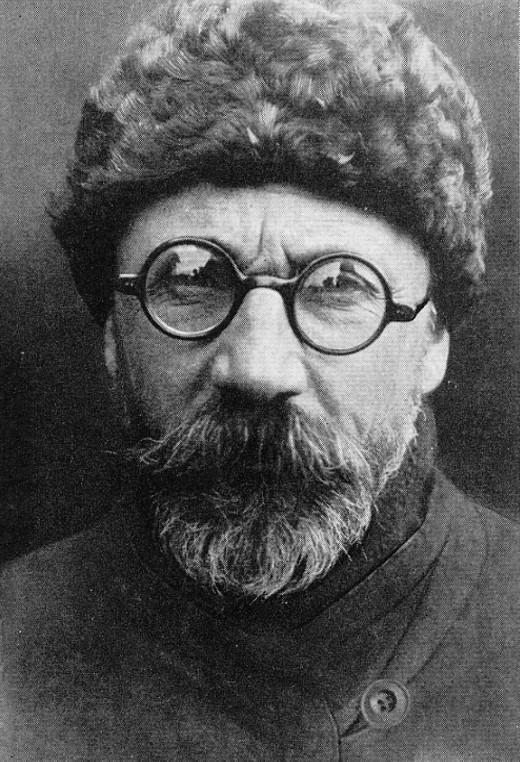
Leonid Kulik
In 1921 he received an assignment to collect meteorites that had fallen in the Soviet Union and also about this time he received a letter describing the experiences of the Evenki people who were camping on the Podkamennaya Tunguska River on the morning of the great explosion. From this vantage point they had a ringside seat to the blast zone, from whence they witnessed the great forest blowdown and were overwhelmed by the intense heat and pressure waves accompanying the blast. About 1923 another letter was sent to him by a geologist who had interviewed a local Tungus herdsman. A translation of the letter reads:
“Fifteen years ago his brother . . . lived on the River Chambe. One day a terrible explosion occurred, the force of which was so great that the forest was flattened for many versts along both banks of the River Chambe. (a verst is a little more than a km) His brother’s hut was flattened to the ground, its roof was carried away by the wind, and most of his reindeer fled in fright. The noise deafened his brother and the shock caused him to suffer a long illness…The Tunguska road had previously crossed this place, but it was now abandoned because it was blocked, impassable, and more over the place aroused terror among the Tungusi people.”
Kulik most likely had access to several newspaper accounts that appeared in the weeks following the mysterious and mighty celestial visitation. One amazing account appeared in a local newspaper Krasnoyarets, dated July 13, 1908 and a translation appeared in E. L. Krinov’s book Giant Meteorites. It describes the events as witnessed in a village about 140 miles south of the blast center.
“Kezhemsk Village . . . An extraordinary atmospheric phenomenon was noticed in this region. At 7.43 a.m. a noise as a strong wind was heard, followed immediately by a fearful crash accompanied by a subterranean shock which caused buildings to tremble. One had the impression that some huge beam or heavy stone had possibly struck the building. This was followed by two further equally forceful blows. The interval between the first and the third blows was accompanied by an extraordinary underground roar like the sound of a number of trains passing simultaneously over rails, and then for five or six minutes followed by a sound like artillery fire. Between fifty and sixty bangs, becoming gradually fainter…the ground trembled…”
Note that the phenomenon is experienced as a powerful force within the Earth as much as it is experienced as an atmospheric force. The account goes on to say
“…As eye-witnesses relate, before the first bangs were heard a heavenly body of a fiery appearance cut across the sky from south to north, inclined to the north east. Neither its size nor shape could be made out owing to its speed and particularly its unexpectedness. However, many people in different villages distinctly saw that when the flying object touched the horizon a huge flame shot up that cut the sky in two…”
Note especially the impression among the eyewitnesses that the flame shooting up cuts the sky in two. The account concludes with potent imagery. Remember, this is from 140 miles away.
“…The glow was so strong that it was reflected in rooms whose windows faced north…Apparently the glow continued for at least a minute, since many peasants in the fields noticed it. The bangs were heard as soon as the “tongue of flame” disappeared. On the island opposite the village horses began to whinny and cows to low and run wildly about. One had the impression that the earth was just about to gape open and everything would be swallowed up in the abyss. Fearful bangs resounded from somewhere, shaking the earth and the invisibility of the source inspired a kind of superstitious terror. People were literally dumbfounded.”
Again, note that in the totality of the event both celestial and terrestrial phenomena are experienced by witnesses.
Another newspaper report from the village of Nizhne-Karelinsk appeared on July 2. This village lay along the flightpath of the Tunguska Cosmic Body, as it has been referred to by Russian scientists, some 290 miles from the blast epicenter.
“At the beginning of the ninth hour in the morning . . . a most unusual phenomenon of nature was observed here. In the village of Nizhne-Karelinsk…in the north west quite high above the horizon, the peasants saw a body shining very brightly (too bright for the naked eye) with a bluish white light . . . when the shining body approached the ground (which was covered with forest at this point) it seemed to be pulverized, and in its place a huge cloud of black smoke was formed and a loud crash . . . as if from the fall of large stones or from gun-fire was heard. All the buildings shook and at the same time a forked tongue of flame broke through the cloud. All the inhabitants of the village ran out into the street in panic. The old women wept, everyone thought that the end of the world was approaching.”
The belief that this event heralded the end of the world was widespread amongst the varied witnesses. This fact has tremendous significance when considering the meaning of pervasive apocalyptic traditions preserved in one form or another around the world. I will continue this story next in the next installment as Kulik embarks on an arduous and epic scientific expedition to reach the blast site, in the process unlocking the door to a great cosmic mystery and uncovering clues to understanding many of the great global changes which have affected the planet, and human civilization, on a regular basis.
Part 5
The Great Siberian Thunderbolt – 2
On the morning of June 30 in the year 1908, a mighty explosion occurred in the skies over eastern Siberia. As a result of this explosion more than 800 square miles of old growth taiga forest was instantly blown over and nearly 100 square miles immediately below the blast epicenter was utterly incinerated. The cause of this blast has been one of the great enduring mysteries of the Twentieth Century. Its significance has not waned with the passage of time, on the contrary, the lessons it has to teach us about the reality of life on Earth are now of the utmost importance. The story it has to tell us is both incomparably grand and ominously revealing as to mysteries long-forgotten or concealed.
As I discussed in Part 4, so remote was the Tunguska explosion that the outside world did not really learn of it until nearly 20 years later, after the first scientific expedition led by Russian scientist Leonid Kulik reached the site in the summer of 1927. That first journey deserves to go down in the annals of history as one of the great scientific expeditions of modern times.
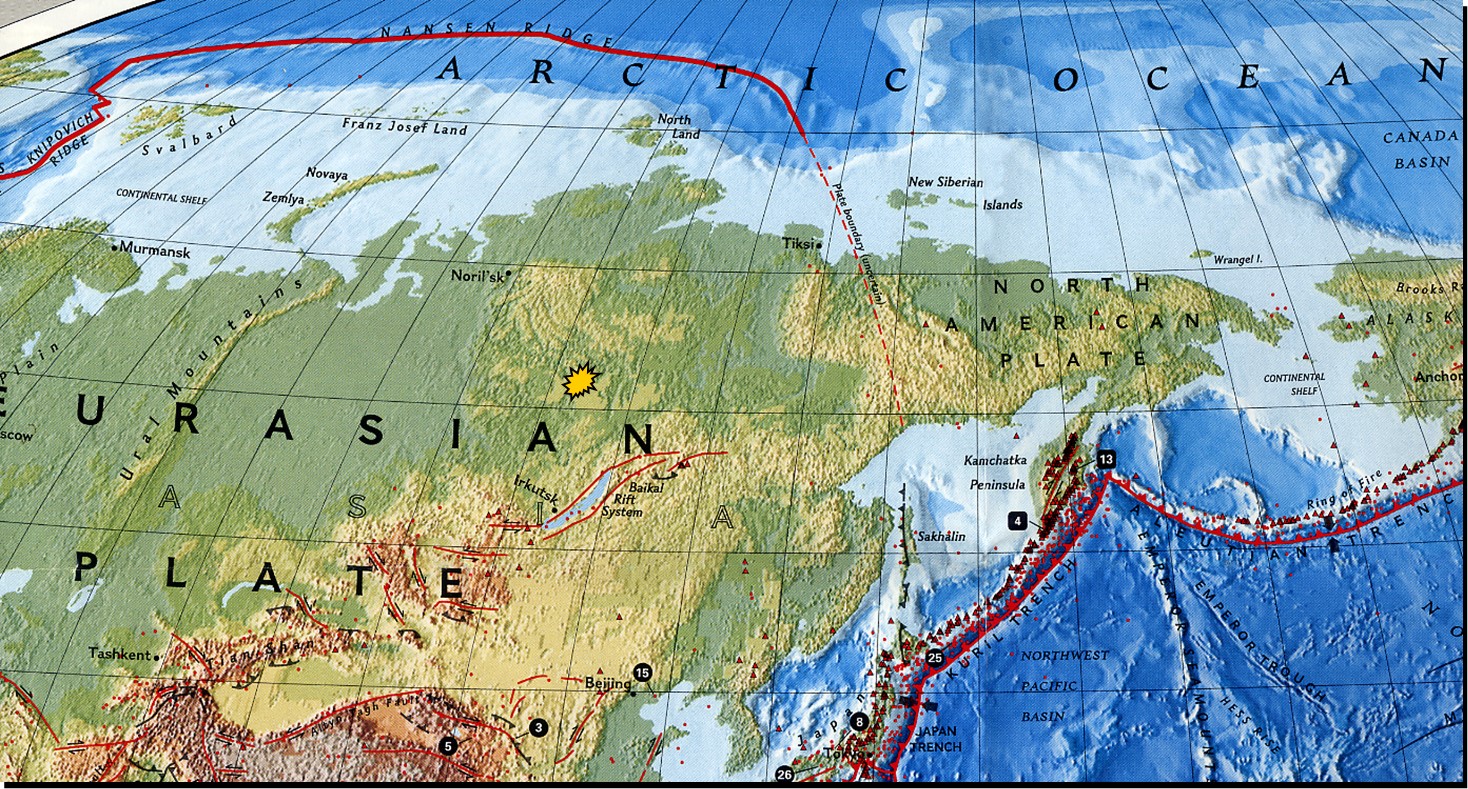
Eastern Siberian location of Tunguska blast site
It began like this. Kulik had been hearing rumors and getting bits and pieces of information from various newspaper accounts, such as I already described. An earlier 1921 trip through Siberia in search of meteorites brought him into contact with a number of second hand accounts and by this time he had become convinced that the explosion was the result of a great meteorite fall. He was, however, only able to determine approximately the area of the blast at that time. He determined to mount an expedition to find the site of the meteorite fall, which, he believed, would have struck the Earth leaving a crater.
Kuliks’ ambition was realized in the spring of 1927 when an expedition was funded by the Russian Academy of Sciences. As noted, since at least 1921 he had been collecting every scrap of information he could find regarding the Tunguska event. He had formed a general idea of the location but only imprecisely. Not having access to accurate maps presented the first challenge to be overcome. He knew that the epicenter lay somewhere to the north of the Podkamennaya Tunguska River and the nearest village was likely to be Vanavara, a small trading post along the river. So he set off on his quest to locate what he expected to be a crater where the meteor had crashed into the Earth.
The Trans-Siberian railway brought Kulik and an assistant to the village of Taishet, about 350 miles from the presumed area of the blast. From there the intrepid scientists proceeded by horse drawn sleds to the village of Khezma, a journey of about 240 miles. After pushing on across steep, forested hills and precipitous gullies, they arrived at Vanavara at the end of March. Vanavara was the final jumping off point before the expedition had to contend with the primeval swampy forests that lay between them and the blast site about 40 miles to the north. It should be understood that Kulik had only a brief window in which to locate the site before the melting of the snow in late spring and the melting of the upper layers of permafrost in early summer. Once the permafrost melted the ground became a near impassable bog swarming with exceptionally vicious mosquitos. Over snow and frozen ground it was possible to make better time than after the spring thaw. However, they had to contend with temperatures as much as 40 degrees below zero.
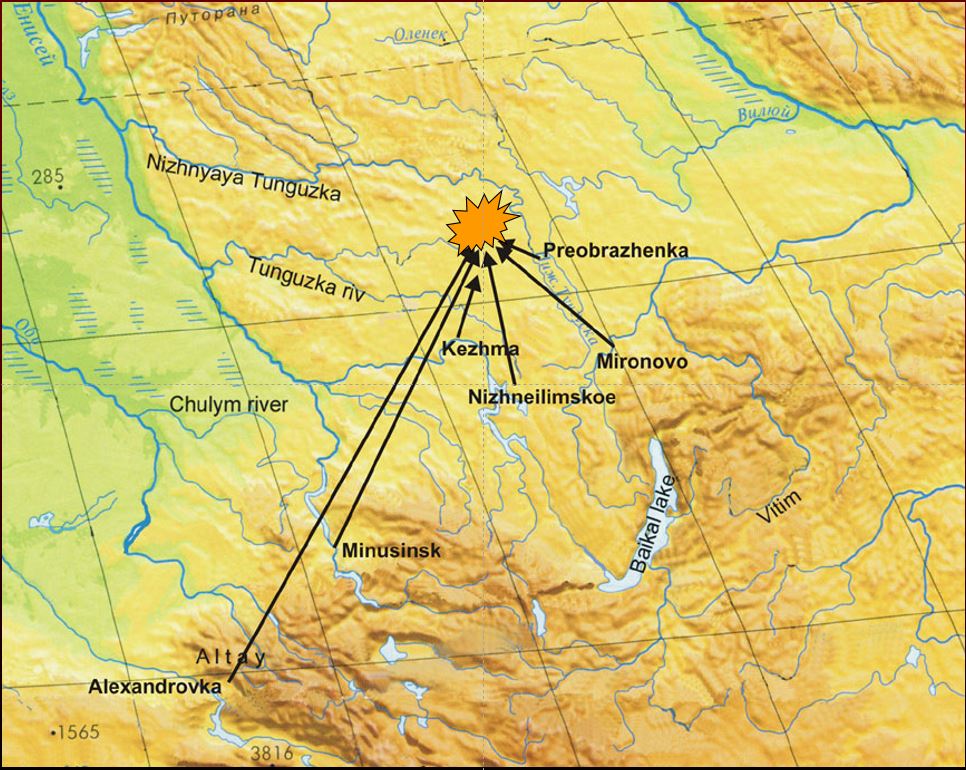
Location of Tunguska blast
In Vanavara Kulik hired a guide named Ilya Potapovich Petrov. He also attempted to interview locals and eyewitnesses to gain a more detailed picture of the event and a more accurate idea of where exactly it had happened and quickly found out that the local people were extremely reluctant to speak of it, holding the whole thing in superstitious dread. It had, in fact, inspired the formation of new religion, in which it was believed that the fire god Agdy had descended to Earth, smashing the forest and decimating animal life as punishment for the transgressions of the wicked. The peasants now believed that the region of the colossal explosion was accursed and would not venture into it. Hearing this only intensified Kuliks’ desire to find and scientifically document the site.
Vanavara, being the closest inhabited community to the blast zone there were some quite extraordinary experiences related by villagers. Meteorite researcher and colleague of Kulik, E. L. Krinov, interviewed many them and included their accounts in his 1966 book Giant Meteorites. One eyewitness, the peasant S. B. Semenov, told Krinov in 1930 that
“I don’t remember the year exactly, but more than twenty years ago when the fallow land was being ploughed up I was sitting on the porch of the house at the trading station of Vanavara at breakfast time and looking towards the north. I had just raised my axe to hoop a cask when suddenly in the north…the sky was split in two, and high above the forest the whole northern part of the sky appeared to be covered with fire. At that moment I felt great heat as if my shirt had caught fire…I wanted to pull off my shirt and throw it away, but at that moment there was a bang in the sky, and a mighty crash was heard . . . I was thrown to the ground about three sajenes [about 21 feet] away from the porch and for a moment I lost consciousness. My wife ran out and carried me into the hut. The crash was followed by noise like stones falling from the sky, or guns firing. The earth trembled, and when I lay on the ground I covered my head because I was afraid that stones might hit it. At the moment when the sky opened, a hot wind, as from a cannon, blew past the huts from the north.”
Semenov, like the eyewitnesses in the newspaper accounts I quoted in Part 4, had the impression that “the sky was split in two” that the sky in effect, “opened.” The other thing that I called the reader’s attention to was that the phenomenon was experienced simultaneously both in the firmament and within the Earth.
Semenov’s daughter, Kosolapova provides another dramatic description.
“I was 19, and when the meteorite fell I was at the trading station of Vanavara. Marpha Bryukhanova and I had come to the spring…for water. Marpha began to draw water, and I was standing beside her facing north. Suddenly before me I saw the sky in the north open to the ground and fire pour out. We were terrified, but the sky closed again and immediately afterwards bangs like gun-shots were heard. We thought that stones were falling from the sky, and rushed off in terror, leaving our pail by the spring…”
“…I ran with my head down and covered, because I was afraid that stones might fall on it…We were terribly frightened at the time. The fire was brighter than the sun. During the bangs the earth and the huts trembled greatly…The noises at first were very loud, and seemed to be right above our heads. . .”
Note this: even though the village of Vanavara is some 40 miles from the blast epicenter, at that distance the blast appeared brighter than the sun. Also, a common impression among many eyewitnesses was the sense that great stones were striking the Earth.
On their first attempt to reach the blast zone Kulik was forced to turn back by the heavy snow. The small party made their second attempt on April 18 with pack horses. Three days out they arrived at the hut of the herdsman Okhchen who joined the group and they traded their horses for reindeer. Kulik and his assistant were suffering from lack of food and a variety of infections inflicted upon them by the vicissitudes of their journey, now approaching ten weeks. Two days of arduous marching brought the exhausted party to the periphery of the great destruction. For two more days they pushed and hacked their way through the dead and prostrate trees. The vast scale of destruction proved to be too much for Potapovich and Okhchen to handle and they abandoned the mission in terror, forcing Kulik to return to Vanavara to hire new guides. Kulik recorded his reaction to the awesome and awful scene in his diary: “I still cannot sort out my chaotic impressions of this excursion…From our observation point no sign of forest can be seen, for everything has been devastated and burned…One has an uncanny feeling when one sees 20”-30” thick giant trees snapped across like twigs, and their tops hurled many metres away…The results of even a cursory examination exceeded all the tales of the eyewitnesses and my wildest expectations…”
The next attempt was commenced on April 30. At this point it had been nearly three months since Kulik set out on his quest. Because of the primitive level of communication Kulik was unable to get word back to his colleagues in St. Petersburg, who began to fear that he might be dead. This time the party decided to travel by raft due to the immense difficulty they had encountered trekking through the forest. However, by late April the rivers had become swollen with spring melt and the brave team had to contend with intense rapids.

Kulik and team crossing the River Kushmo
Abandoning the rafts after traveling by river as far as possible they once more set out on foot. On May 20 Kulik again reached the edge of the great forest blowdown.
For the next week they pushed through the tangle of dead trees, always moving towards the center of the blast zone. Arriving at the mouth of the Churgima River, Kulik and his team set up camp, from whence they ventured out on daily treks. For nine days Kulik explored, finally realizing that the prostrate forest was splayed out radially from an epicenter that the guides referred to as the Southern Swamp.
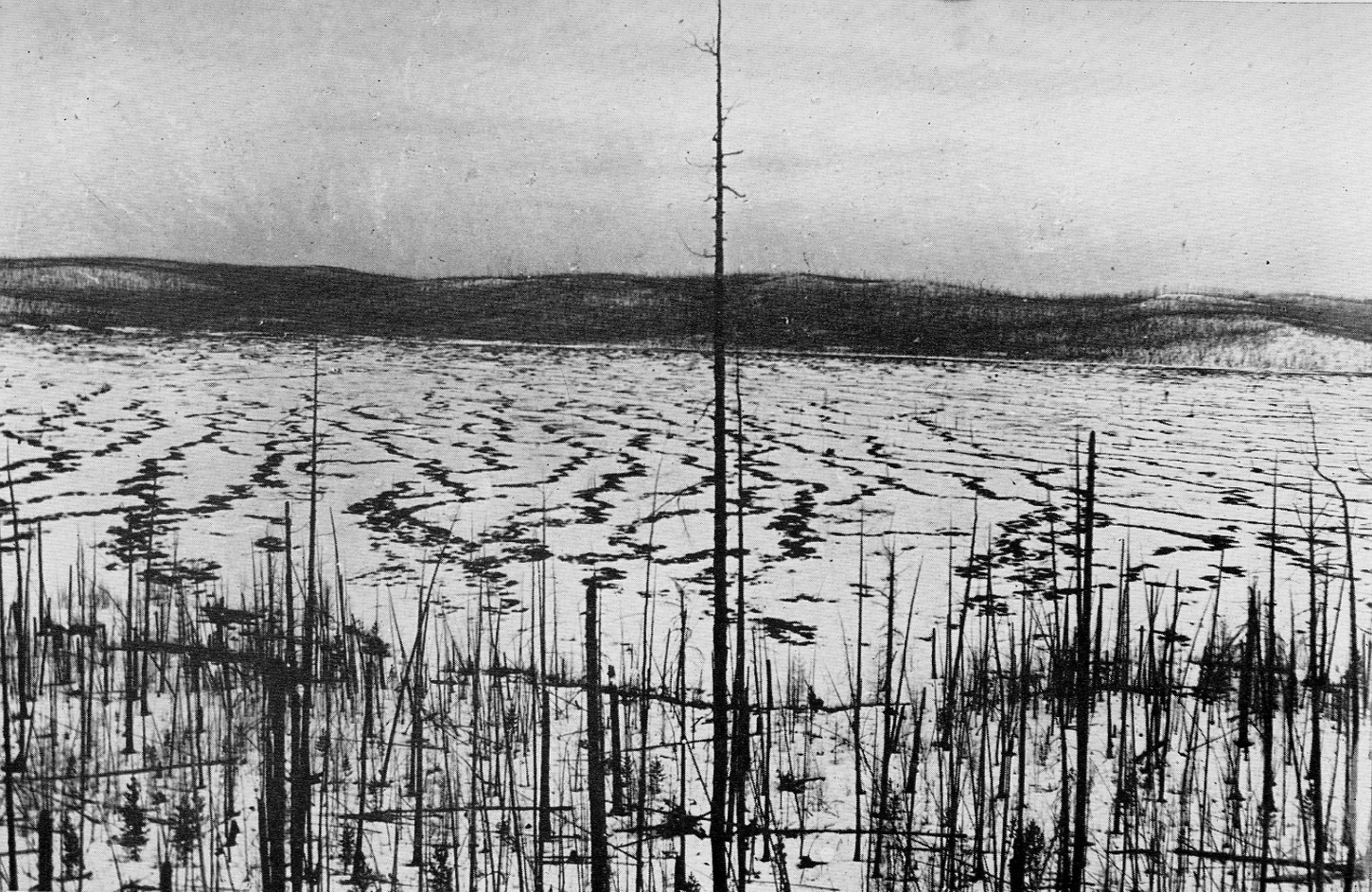
The ‘Southern Swamp’ at ground zero
It was here Kulik believed that he would find his crater. What he found instead was a bizarre landscape where, in his words, “the solid ground heaved outward from the spot in giant waves, like waves in water.”
In addition he saw numerous depressions in the peat marsh that he described as “peculiar flat holes.” These holes, he believed, must have been formed by pieces of the meteorite striking the ground. In a later expedition Kulik undertook the excavation of one of these holes but was disappointed to find no trace of a meteorite.

The ‘Suslov Hole’ in 1929 after being drained
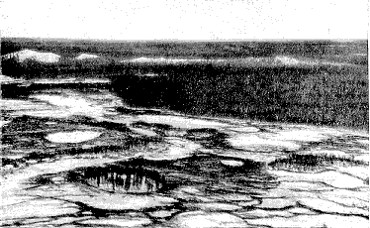
Elliptical crater swamps
His final expedition to the blast zone was undertaken in 1938. Shortly after, World War 2 broke out and Kulik joined the fight against the Nazis. He was captured and died of typhus in a Nazi prison camp on April 24, 1942, a tragic loss to the world of science.
The legacy of Kuliks’ research expeditions is of the utmost importance not just to the abstract domain of science and academia, but to the world at large. As already stated, I believe the Tunguska blast will prove to be as far reaching in its historical ramifications as any great event of the 20th century, including two world wars, the discovery of atomic energy and the advent of the space program. As we continue to learn more about this amazing event the mysteries grow deeper and the significance to understanding both our past and our future escalates.
One of Kuliks’ successors, Russian scientist I. S. Astapowitch, wrote in 1934 that
“The flight and fall of the meteorite on 30th June, 1908, amongst the greatest meteoric phenomena known to mankind, must occupy one of the foremost places because of the magnitude of the phenomena accompanying its movement through the atmosphere . . . it is unlikely that our generation may again be witnesses of a similar meteoric phenomenon; if it had occurred 4 hr. 47 m. later, when the city of Leningrad would have lain on the same parallel near the center of the explosion, our knowledge of it would probably have been considerably more extensive…” (Astapowitch, I. S. (1934) Air Waves Caused by the Fall of the Meteorite on 30th June, 1908, in Central Siberia: Quarterly Journal of the Royal Meteorological Society, Vol. 60, pp. 493 – 503)
Had the center of the explosion occurred 4 hours and 47 minutes later as Astapowitch conjectures, it is a certainty that the historical record of the 20th Century would have been dramatically different.
In Part 6 of this series I will probe deeper into the mysteries of this powerful cosmic event and the critically important lessons it has to teach us.
Part 6
The Great Siberian Thunderbolt – 3
On June 30, just after 7 a.m. local time in the year 1908, eyewitnesses in a remote region of Siberia experienced a demonstration of the awesome power of cosmic events to affect life on Earth. More than a century later we are still learning the lessons and deciphering the mysteries surrounding this phenomenal occurrence, and are only just beginning to grasp the implications for our own future. While political partisans and self-described environmentalists go into hysterics over a miniscule increase in a beneficial atmospheric trace gas (.0001 increase of CO2 concentration in the past century relative to total atmospheric composition) the cosmos continues to remind us, and the surface of the Earth bears witness to, the fact that far more frequently than anyone has imagined, interactions between the Earth and the heavens occur, with profound consequences to the full range of terrestrial existence.
Over the decades, since that first heroic expedition by Leonid Kulik in 1927, information trickled out of the Soviet Union and the world at large slowly became aware of the powerful explosion that utterly decimated over 800 square miles of forest. With the end of the Cold War, American scientists gained access to a tremendous trove of Russian research into the Tunguska Event, as it has come to be called, as well as the ability to research the site first hand. While this has made a wealth of new knowledge and information available to American scientists and scholars, in my opinion however, the import of this phenomenon has largely gone unrecognized. You know from the two previous articles that early in the morning of that fateful day some type of celestial visitor, either a comet, an asteroid, or something in-between, descended rapidly through the Earth’s atmosphere with such force that it blew itself up about 5 miles above the surface. The blast wave demolished over 800 square miles of old growth, taiga forest. This area is roughly equal to the areas found inside the perimeter interstate highways that encircle many major cities in the U.S., for example I-285 surrounding Atlanta or I-495 surrounding Washington D.C. The blast zone was extensive enough to utterly decimate any major urban area in the U.S. Were a cosmic blast of equivalent magnitude to occur over a large U.S. city today there could potentially be more than a million casualties. The devastation of New Orleans in the wake of Hurricane Katrina would pale by comparison. And unlike a calamity brought on by a hurricane, there would be no warning of the impending event. A celestial object the size of the Tunguska meteorite still falls below our present long term observational and prediction capabilities.
One of the first major reports to reach the educated public of the western world appeared in the July, 1928 issue of Scientific American. The article was written by Charles P. Olivier, at the time chairman of the Meteor Commission of the International Astronomical Union. He writes:
“Recently reports have been reaching the scientific world of a wonderful meteoric fall in one of the most inaccessible parts of Siberia. During the past year there have been several references to it in the scientific and popular journals, but the official account of the exploration of the locality by the Academy of Sciences of the U.S.S.R. has only just been received.”
By 1928, with those first early reports reaching western scientists, it was realized that a variety of effects of this great explosion had actually been observed at many locations thousands of miles distant from the blast epicenter, but not associated with it at the time. The May 1931 issue of Scientific American featured an article by the scientific correspondent for The Manchester Guardian, J. G. Crowther. In this article Crowther makes an appeal to the readers. He writes that those who live in the United States, Canada and Japan “and keep diaries may be able to provide some special information of value to meteorologists. It concerns the atmospheric and sunset effects of the great meteorite which fell in Siberia . . . That the fall actually took place became generally known only in 1928 and since then some remarkable new information has been discovered.” Crowther recounts a discussion that occurred at the Dublin meeting of the British Association for the Advancement of Science in 1908, concerning wave motion. He writes: “Dr. N. W. Shaw contributed an example of a curious atmospheric wave-motion recorded on the self-recording micro-barograph invented by himself and Mr. W. H Dines in 1903. This instrument automatically records sudden small changes in atmospheric pressure such as those due to air waves . . . On June 30th, 1908, six of these instruments in England . . . recorded a series of air waves arriving during a period of about 20 minutes, with about four fairly plain maxima, as if there had been four disturbances or explosions somewhere in the earth’s atmosphere during that period. After the discussion this record was more or less forgotten and became one of the unexplained curiosities of meteorological science.” In other words, the powerful air waves produced by the blast passed over England and registered on newly invented atmospheric pressure instruments. In fact, the aerial waves were so powerful they passed completely around the world twice, with both passages being registered on the barographs. But at the time, no one made the connection between these unusual atmospheric pressure waves and the rumors coming out of Siberia about some type of great meteor fall.

Microbarograms

Composite barogram
Around 1935 Kulik received a letter from an eyewitness named Naumenko who observed the event from the village of Kezhma, about 140 miles south of the blast.
“The day was unusually clear and not a single cloud was to be seen. No wind stirred, and there was absolute silence. Suddenly, far off, still hardly audible, was heard the sound of thunder. It made us look up involuntarily in every direction. The sound seemed to come from beyond the River Angara and became louder rapidly. There was something extraordinary about it . . .The first fairly faint crash resounded, but when I turned quickly in the direction of the crash I saw that the Sun’s rays were crossed by a broad fiery-white band on the right side of its rays. On the left side, towards the north, an irregularly- shaped brilliantly white somewhat elongated mass was flying into the taiga…with a diameter far greater than the Moon’s. Approximately two to three seconds, maybe that generally heard during a storm. After the second crash, the “ball” was no longer visible, but its tail, or rather the streamer, was now completely on the left side of the Sun’s rays . . . Then, after a shorter interval of time than that between the first and second crashes, the third thunder crash occurred. This was so loud (as though there were several crashes all mingled together within it) that the whole ground trembled. An echo, like a continuous deafening roar, resounded through the taiga, indeed it seemed through the whole taiga of vast Siberia.”
As emphasized in the two preceding installments, the phenomenon had a powerful terrestrial component, in fact, it registered as a 5+ earthquake on the Richter scale. This was the result of the massive amount of energy released by the blast subsequently absorbed by the Earth. Also note the reference to the quality of the environment immediately preceding the arrival of the great meteor – it was absolutely still and silent. This served to accentuate the first audible indication of the approaching object even more dramatically.
Naumenkos’ letter goes on to describe the reaction of other eyewitnesses from the village.
“The carpenters, after the first and second crashes, had crossed themselves in stupefaction, and when the third crash resounded they fell backwards from the building on to the chips of wood. Some of them were so stunned and utterly terrified that I had to calm them down and reassure them. We all abandoned work and went into the village. There, whole crowds of local inhabitants were gathered in the streets in terror, talking about the phenomenon.”
Kuliks’ colleague Krinov in his work relates many eyewitness accounts. Among those was the account by the boatman Kokorin who was sailing down the River Angara, not far from the village of Boguchany, which is about 230 miles from the blast center.
“In the north a pale bluish light glowed, and from the south a fiery body that was considerably larger than the Sun and left a broad bright streamer behind it flew across the sky. Then such a cannonade broke out that all the workmen who were in the boat rushed to hide in the cabin, forgetting all about the danger that threatened from the rapids. The first bangs were faint, but became progressively louder. The sound effect, he estimated, lasted three to five minutes. The intensity of the sounds was so great that the boatmen were completely demoralized.”
One truly amazing phenomenon associated with the fall of the great meteorite was described by Krinov.
“On the first night after the fall of the Tunguska meteorite, i.e. from 30 June to 1 July 1908, and with lesser intensity on a few successive nights, extraordinary optical phenomena were observed in the Earth’s atmosphere.
Everywhere in Western Siberia and over all Europe, the attention of scientists and of a large number of people was primarily attracted by the unusually bright nights. In fact, it may be said that from 30 June to 1 July there was no night at all. . . At the same time, massive glowing silvery clouds were seen against a background of brilliant, colourful sunsets . . .”

Map of reported ‘light nights’
The strange effect of anomalously bright nights over northern Europe in the aftermath of the Tunguska event has been the subject of much debate, and provides important clues as to the identity of this celestial intruder. As more details emerge, the mystery of the Tunguska Event deepens. I will pick up the thread of this extraordinary tale in Part 7 of this series on the “Cosmic Factor” in history.
